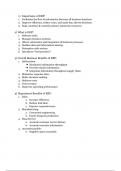Summary
Summary ERP Revision
- Module
- Erp (BIS352E)
- Institution
- University Of Northampton (UoN)
An Enterprise Resource Planning (ERP) system is a suite of integrated applications that a company can use to collect, store, manage, and interpret data from many business activities. ERP provides an integrated and continuously updated view of core business processes using common databases maintaine...
[Show more]



